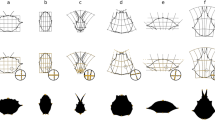Abstract
The dermatoglyphic characteristics of a sample of mountain Talyshes are provided and compared with a Talysh population of the Caspian Lowland and the main races of Caucasia, taking into account the characters of sexual dimorphism and bilateral asymmetry. It is shown that many dermatoglyphic traits of sexual differences coincide with differences between the right and left hands. Based on the assumption of the leading role of males and right hands of humans in evolution, the major trends in the evolution of dermatoglyphics are recognized. Our conclusions are indirectly confirmed by the fact that traits that are regarded as advanced show increased variability.
Similar content being viewed by others
References
Abdushelishvili, M.G., Antropologiya drevnego i sovremennogo naseleniya Gruzii (Anthropology of Ancient and Modern Populations of Georgia), Tbilisi, 1964.
Alekseev, V.P., Proiskhozhdenie narodov Kavkaza (Thr Origin of Peoples of the Caucasus), Moscow, 1974.
Anserov, N.I., Talyshi, mediko-antropologicheskoe issledovanie (Talyshes: Health Anthropological Study), Baku: AZGNII, 1932.
Bunak, V.V., Antropometriya (Anthropometry), Moscow: Uchpedgiz, 1941.
Cummins, H. and Midlo, C., Finger Patterns, Palms and Soles: An Introduction to Dermatoglyphics, Philadelphia: Blakiston Co, 1943.
Cummins, H. and Midlo, Ch., Introduction to Dermatoglyphics, New York: Dover Publ., 1961.
Debets, G.F., Anthropological studies in Dagestan, Tr. Inst. Etnogr. Akad. Nauk SSSR, Nov, Ser., 1956, vol. 33, pp. 1–122.
Geodakyan, V.A., The role of sex in transfer and transformation of genetic information, Probl. Peredachi Inform., 1965, vol. 1, no. 1, pp. 105–112.
Geodakyan, V.A., Evolutionary logic of sexual differentiation in phylogeny and ontogeny, Doctoral Dissertation in Biology, Moscow: Inst. Biol. Razv. Akad. Nauk SSSR, 1987.
Geodakyan, V.A., Evolutionary chromosomes and evolutionary sexual dimorphism, Izv. Akad. Nauk, Ser. Biol., 2000, no. 2, pp. 133–148.
Gladkova, T.D., Kozhnye uzory kisti i stopy obez’yan i cheloveka (Skin Patterns of Hand and Foot in Monkeys and Humans), Moscow: Nauka, 1966.
Kasimova, R.M., Antropologicheskie issledovaniya sovremennogo naseleniya Azerbaidzhanskoi SSR (Anthropological Studies of Modern Population of Azerbaijan), Baku, 1975.
Khit’, G.L., Dermatoglyphics of population of Finland and adjacent regions, Vopr. Antrop., 1969, vol. 32, pp. 163–171.
Khit’, G.L., Dermatoglifika narodov SSSR (Dermatoglyphics of Peoples of the USSR), Moscow: Nauka, 1983.
Khit’, G.L. and Dolinova, N.A., Rasovaya differentsiatsiya chelovechestva (Dermatoglificheskie dannye) (Racial Differentiation of Mankind: Dermatoglyphic Data), Moscow: Nauka, 1990.
Marr, N.Ya., Talyshes, Tr. Kom. Izuch. Plemen. Sost. Naseil. Rossii (Petrograd), 1922, vol. 4, pp. 1–24.
Otchet o rabote po proektu “Genetika mozga i psikhologicheskikh osobennostei cheloveka; sistemogenez: kompleksnoe issledovanie” (Report on Genetics of the Brain and Psychological Features of Humans: Systemogenesis: Complex Study), Ata-Muradova, F.A, Ed., Moscow: Inst. Evol. Morfol. Ekol. Zhiv. Akad. Nauk SSSR, 1989.
Rasskin-Gutman, D. and Izpisúa-Belmonte, J.C., Theoretical morphology of developmental asymmetries, BioEssays, 2004, vol. 26, pp. 405–412.
Rautian, A.S., Paleontology as a source of information on laws and factors of evolution, in Sovremennaya paleontologiya (Modern Paleontology), Moscow: Nedra, 1988, vol. 2, pp. 76–118.
Rautian, G.S., Fluctuating asymmetry in skull characters, in Zubr na Kavkaze (Wisent in the Caucasus), Moscow-Maikop: Kachestvo, 2003, pp. 97–107.
Sharma, A., Comparative methodology in dermatoglyphics, in International Committee for Standardization in Human Biology, Moscow, 1964.
Zakharov, V.M., Asimmetriya zhivotnykh (populyatsionnofenogeneticheskii podkhod) (Asymmetry of Animals: Population Phenogenetic Approach), Moscow: Nauka, 1987.
Author information
Authors and Affiliations
Corresponding author
Rights and permissions
About this article
Cite this article
Rautian, G.S. Bilateral asymmetry as a source of information on the evolutionary trends, using dermatoglyphics of Talyshes as an example. Paleontol. J. 48, 1309–1314 (2014). https://doi.org/10.1134/S0031030114120089
Received:
Published:
Issue Date:
DOI: https://doi.org/10.1134/S0031030114120089




